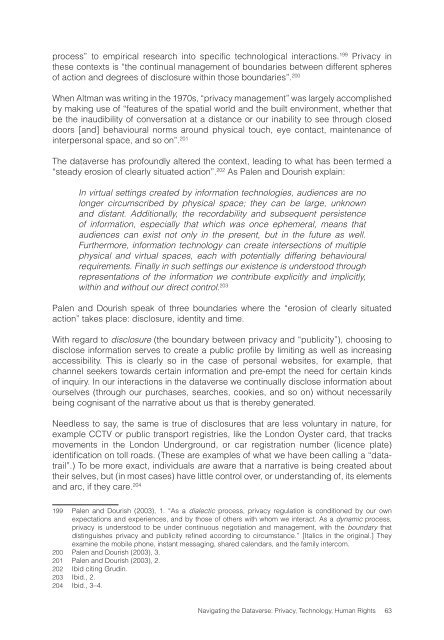Navigating the Dataverse: Privacy, Technology ... - The ICHRP
Navigating the Dataverse: Privacy, Technology ... - The ICHRP
Navigating the Dataverse: Privacy, Technology ... - The ICHRP
You also want an ePaper? Increase the reach of your titles
YUMPU automatically turns print PDFs into web optimized ePapers that Google loves.
process” to empirical research into specific technological interactions. 199 <strong>Privacy</strong> in<br />
<strong>the</strong>se contexts is “<strong>the</strong> continual management of boundaries between different spheres<br />
of action and degrees of disclosure within those boundaries”. 200<br />
When Altman was writing in <strong>the</strong> 1970s, “privacy management” was largely accomplished<br />
by making use of “features of <strong>the</strong> spatial world and <strong>the</strong> built environment, whe<strong>the</strong>r that<br />
be <strong>the</strong> inaudibility of conversation at a distance or our inability to see through closed<br />
doors [and] behavioural norms around physical touch, eye contact, maintenance of<br />
interpersonal space, and so on”. 201<br />
<strong>The</strong> dataverse has profoundly altered <strong>the</strong> context, leading to what has been termed a<br />
“steady erosion of clearly situated action”. 202 As Palen and Dourish explain:<br />
In virtual settings created by information technologies, audiences are no<br />
longer circumscribed by physical space; <strong>the</strong>y can be large, unknown<br />
and distant. Additionally, <strong>the</strong> recordability and subsequent persistence<br />
of information, especially that which was once ephemeral, means that<br />
audiences can exist not only in <strong>the</strong> present, but in <strong>the</strong> future as well.<br />
Fur<strong>the</strong>rmore, information technology can create intersections of multiple<br />
physical and virtual spaces, each with potentially differing behavioural<br />
requirements. Finally in such settings our existence is understood through<br />
representations of <strong>the</strong> information we contribute explicitly and implicitly,<br />
within and without our direct control. 203<br />
Palen and Dourish speak of three boundaries where <strong>the</strong> “erosion of clearly situated<br />
action” takes place: disclosure, identity and time.<br />
With regard to disclosure (<strong>the</strong> boundary between privacy and “publicity”), choosing to<br />
disclose information serves to create a public profile by limiting as well as increasing<br />
accessibility. This is clearly so in <strong>the</strong> case of personal websites, for example, that<br />
channel seekers towards certain information and pre-empt <strong>the</strong> need for certain kinds<br />
of inquiry. In our interactions in <strong>the</strong> dataverse we continually disclose information about<br />
ourselves (through our purchases, searches, cookies, and so on) without necessarily<br />
being cognisant of <strong>the</strong> narrative about us that is <strong>the</strong>reby generated.<br />
Needless to say, <strong>the</strong> same is true of disclosures that are less voluntary in nature, for<br />
example CCTV or public transport registries, like <strong>the</strong> London Oyster card, that tracks<br />
movements in <strong>the</strong> London Underground, or car registration number (licence plate)<br />
identification on toll roads. (<strong>The</strong>se are examples of what we have been calling a “datatrail”.)<br />
To be more exact, individuals are aware that a narrative is being created about<br />
<strong>the</strong>ir selves, but (in most cases) have little control over, or understanding of, its elements<br />
and arc, if <strong>the</strong>y care. 204<br />
199 Palen and Dourish (2003), 1. “As a dialectic process, privacy regulation is conditioned by our own<br />
expectations and experiences, and by those of o<strong>the</strong>rs with whom we interact. As a dynamic process,<br />
privacy is understood to be under continuous negotiation and management, with <strong>the</strong> boundary that<br />
distinguishes privacy and publicity refined according to circumstance.” [Italics in <strong>the</strong> original.] <strong>The</strong>y<br />
examine <strong>the</strong> mobile phone, instant messaging, shared calendars, and <strong>the</strong> family intercom.<br />
200 Palen and Dourish (2003), 3.<br />
201 Palen and Dourish (2003), 2.<br />
202 Ibid citing Grudin.<br />
203 Ibid., 2.<br />
204 Ibid., 3–4.<br />
<strong>Navigating</strong> <strong>the</strong> <strong>Dataverse</strong>: <strong>Privacy</strong>, <strong>Technology</strong>, Human Rights 63
















